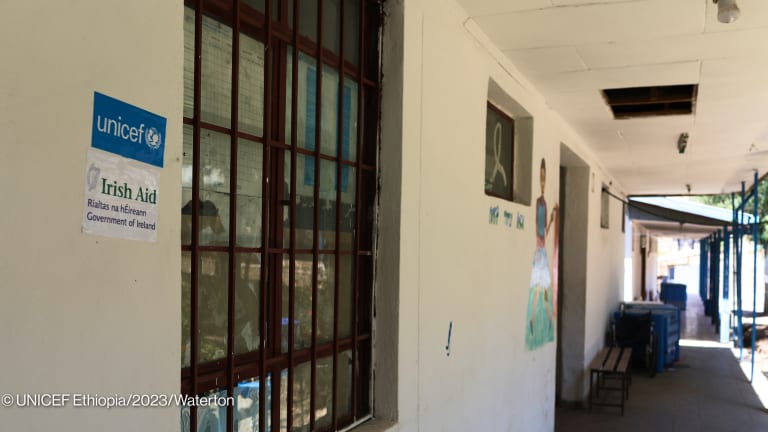Hunger and the food crisis: What does the data tell us?
While food aid increased by $667.7 million in 2020, the number of undernourished people also increased. We looked into the data to see what donors are doing.
Nearly four months after the Russian invasion of Ukraine, lower-income countries have braced themselves as the prices of basic commodities continue to skyrocket. The two countries play a big role in the global food supply chain — delivering half of North Africa and the Middle East’s supply of cereal and a large portion of its wheat and barley. Altogether they are responsible for 12% of all calories traded globally. Ukraine also supplies half of the sunflower oil in the global market, while Russia is a major exporter of fertilizers. The current sanctions from the West have hit the trade in these goods. Since last year, fertilizer prices have more than doubled. Russian sanctions have also hit the price of oil, which has made transporting food more expensive. The cost of delivering aid has increased due to the oil price hike. As of May 2022, the food price index, which measures monthly changes in prices of a basket of food commodities, was at 157.4 points. In March 2022, it averaged 159.7 points — the highest level since its inception in 1990. In 2020, for comparison, the index averaged 98.1 points. The impact of the war has added pressure to an already fragile situation. Even before the conflict, tens of millions of people were already close to experiencing famine due to existing local conflicts, rising costs of commodities, climate change, and the pandemic. Now, with the added pressure of the war, the world is on the brink of a devastating food crisis. Data on food aid shows that last year’s levels were not adequate to meet preexisting needs, and radical change will be needed to address additional issues caused by war. We look at the picture the data reveals. Food aid is rising, but so is the number of people affected by hunger Based on the latest data from the Organisation for Economic Co-operation and Development, bilateral food aid has increased in the last decade. Inflation-adjusted figures show a rise from $2.8 billion in 2011 to $6.5 billion in 2020 — a 132% real-terms increase. The United States topped the list of food aid donors in 2020, contributing $2.5 billion. Turkey, a non-DAC donor, ranked next, with $2.2 billion, although this was allocated mainly due to an influx of Syrian refugees. Other large donors include Germany, with $703.7 million; the United Kingdom, with $335.3 million; and Canada, with $166.6 million. Overall, Development Assistance Committee member countries allocated $4.2 billion for food aid that year. How many people are affected by hunger? Although there is a rise in food aid, we have not seen the numbers of people facing hunger or are chronically hungry/undernourished, decreasing: While food aid increased by $667.7 million in 2020, the number of undernourished people also increased. The Food and Agriculture Organization identifies individuals as “facing hunger” when their habitual food consumption is insufficient. In 2019, there were 650 million people in this group, but in 2020 this rose to somewhere between 720 and 811 million — with a margin for error due to the difficulty of collecting data. An alternative measure, the World Food Programme’s live tracker, HungerMap, showed that 768 million were chronically hungry in 2020. Somalia, the Central African Republic, Haiti, Yemen, and Madagascar recorded the highest rate of undernourishment that year. As of publication, 864 million people do not have sufficient food consumption, with the top 12 countries accounting for 173.5 million people, or 20% of the total number. Afghanistan and Somalia recorded the highest prevalence of insufficient food consumption — with 92% of their population. How much is needed to end world hunger? A paper published by the International Food Policy and Research Institute in 2018 identifies different approaches to this question. The World Bank’s Investment Framework for Nutrition estimated that an additional $7 billion annually from 2015 to 2025 was needed to meet World Health Assembly goals on reducing undernutrition — a figure which predates both the pandemic and the war in Ukraine. This figure looks primarily at the cost of “targeted nutrition interventions” to help people currently hungry, and does not address the root causes of hunger. On the other hand, following the Achieving Zero Hunger — a multisectoral approach from FAO, WFP, and the International Fund for Agricultural Development — requires a far bigger additional annual cost — $265 billion. This approach looks at what is needed to ensure enough food is produced, and that everyone has sufficient resources to purchase it. What donors are currently doing A report from FAO revealed that the number of people affected by moderate or severe food insecurity has been slowly increasing since 2014. The report said that existing levels of efforts of bilateral and multilateral aid institutions have not led to progress in either ensuring access to food or eradicating malnutrition. This is due to a number of reasons, including disruptions in the global supply chain, economic and social crises, and climate change. OECD already released its preliminary aid data for 2021, but we are yet to see updates on food aid figures. But following the most recent crisis, bilateral donors and multilateral organizations have been taking some action. Recent funding includes: • Over $30 billion from the World Bank — $12 billion for new projects and $18.7 billion for existing projects supporting agriculture, social protection, water and irrigation, and other sectors related to food and nutrition. • $1.5 billion from the African Development Bank for the African Emergency Food Production Facility, which will support 20 million smallholder farmers in the region. • $1 billion over the next three years from OPEC Fund for International Development for the Food Security Action Plan, which will provide assistance to its partner countries by covering import costs of basic commodities. • A €600 million ($631.7 million) plan from the European Commission — €350 million for food production and resilient food systems, €150 million aid, and €100 million for macroeconomic and fiscal stability in selected Africa, Caribbean, and Pacific countries. • Over $600 million in loans from the Asian Development Bank to stabilize food supply and prices among its member countries. • $331 million from the U.S. Agency for International Development — $198 million for emergency food security programming and more than $132 million, through Feed the Future, for smallholder farmers in Latin America and the Caribbean. The agency is also providing another $225 million additional humanitarian assistance to Ukraine and $105 million for humanitarian aid and food assistance in the Horn of Africa. Since the Russian invasion of Ukraine, the U.S. has provided over $2.6 billion in emergency food assistance around the world. With the three new announcements in June, Devex estimates U.S. global food aid to be around $3.3 billion. • €430 million from the German government to fight global hunger — $238 million to support sustainable agriculture and education and $192 million for WFP’s World Without Hunger initiative. • $100 million from the Canadian government to AfDB to support small- and medium-sized agri-food enterprises. Conclusion Hunger has plagued countries such as Ethiopia, Sudan, and Yemen for decades and it’s a rather disturbing reality. And now talks about having better policies and taking more drastic actions only started to come up again now that the current food crisis poses a global threat, even to the West. Food aid is one aspect, but it is definitely not the only key to solving world hunger — which is a multifaceted issue. Diversification of crops is one; strengthening the food system in Africa is another. There is a pool of potential solutions, but resources remain limited. As donors and multilateral organizations try to increase their efforts in addressing the current food crisis, a lot more could be done to prevent another one from happening in the future. Sadly, we are still far from achieving zero hunger by 2030. Try out Devex Pro Funding today with a free five-day trial, and explore funding opportunities from over 850 sources in addition to our analysis and news content.
Nearly four months after the Russian invasion of Ukraine, lower-income countries have braced themselves as the prices of basic commodities continue to skyrocket.
The two countries play a big role in the global food supply chain — delivering half of North Africa and the Middle East’s supply of cereal and a large portion of its wheat and barley. Altogether they are responsible for 12% of all calories traded globally.
Ukraine also supplies half of the sunflower oil in the global market, while Russia is a major exporter of fertilizers. The current sanctions from the West have hit the trade in these goods. Since last year, fertilizer prices have more than doubled.
This story is forDevex Promembers
Unlock this story now with a 15-day free trial of Devex Pro.
With a Devex Pro subscription you'll get access to deeper analysis and exclusive insights from our reporters and analysts.
Start my free trialRequest a group subscription Printing articles to share with others is a breach of our terms and conditions and copyright policy. Please use the sharing options on the left side of the article. Devex Pro members may share up to 10 articles per month using the Pro share tool ( ).
Miguel Tamonan is a Senior Development Analyst at Devex, where he analyzes data from public and private donors to produce content and special reports for Pro and Pro Funding readers. He has a bachelor’s degree in Political Science with a Major in International Relations from the Polytechnic University of the Philippines.








